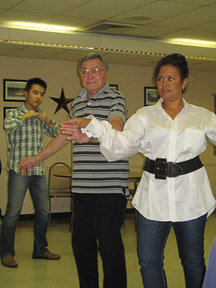At their wedding, it’s common for the bride and groom to be afflicted by a case of the pre-wedding jitters, or “cold feet,” but for those enrolled in James Festa’s ballroom classes, one thing they won’t have to worry about is two left feet.
Couple Anna Shen and Kevin Wang, are set to wed Dec. 11 in China, and Festa, with the help of his other students, is planning their wedding dance.
“They’re going to be nervous that day. Why don’t I make them secure about something?” Festa said.
But here, it’s not all about the dance steps. Throughout the night, the soon-to-be bride and groom danced with several other students, who kept the tempo with advice and support.
“It’s a wonderful way to meet people in the community,” – Judy Finkelstein
________
The program
Sponsored by the Weehawken Recreation Department, the free 10-week fall ballroom dancing program with the legendary James Festa started on Oct. 6, and takes place every Wednesday from 7 p.m. to 9 p.m. at the Senior/Nutrition Center, 203 Highwood Ave.
The only requirement for participants is residence in Weehawken. All ages are welcome, and those who have not attended previous meetings can join at any time.
For those that miss the fall sessions, Festa’s free 10-week ballroom instruction returns in the spring, right in time, he says, for the high school prom.
In the program, students learn three dances – fox trot, rumba, and the waltz – using only four steps.
Of his stress on simplicity, Festa declared, “A lot of people want a lot of steps, and then they can’t do them! What they get here is that they can actually do it.”
Men, especially, Festa says, would benefit from his program.
“The poor man has to think about his hands, brain, and feet. I go crazy getting the guy to actually lead her,” Festa said, throwing up his hands. “She’s not a mind reader…That’s why I want the girl to be 50 percent independent. Most men are lousy.”
Lousy leading isn’t only problem that makes its way into ballroom dancing. Dancers, according to Festa, need to part with the idea that slow music equals slow dancing.
“A lot of people hear slow music and they get duller!” Festa says, adding that dancers need to take slow music and make it more exciting.
But there’s no room for stiff, herky-jerky steps in Festa’s program, where it’s all about fluidity.
“I don’t want it to look hurried, I don’t want it to look like you’re working like hell. I want it to flow,” he said.
Festa’s extended family
There’s a feeling of connectedness with Festa’s program that doesn’t necessarily have to do with pushing off with your left knee when you step back with your right foot. Here, there’s a connection between Festa’s students, most of whom have known Festa for years, or who have been acquainted with his classes through others.
At the start of the lesson, self-described dear friend and former student of Festa, Pauline Dobish, swung by to discuss with Festa the performance by Weehawken seniors over the Halloween weekend, for which Festa had instructed them in the waltz, the rumba, the cha cha, and the fox trot.
In an aside, Dobish informed the class, “Fifty years ago, he taught me at Weehawken high school,” to which another student, Robin Gordon, recounted that her friend has been taught by Festa when she was three.
“My girlfriend talked me into it. I’ve always wanted to take lessons but never (a.) had the time and (b.) had someone to go with,” Gordon said.
Though her friend has not attended recent meetings, and a fresh cast is wrapped about her foot, such obstacles don’t keep Gordon away from the classes. There are other singles that attend, and couples often switch partners to help one another out.
Rusty Dantis, who joined Gordon several times on the dance floor, has been coming to the dance lessons for about three years, “just for fun.” Himself an instructor, Dantis said he does Latin ballroom dancing, comparing it to the dancing seen in “Dancing with the Stars,” and teaches privately the tango, the waltz, and the international rumba.
In between dances, Dantis glanced at a ballroom dancing music CD given to Festa by one of the students unable to attend that night, and showed pictures of his new grandson to fellow students.
“It’s a wonderful way to meet people in the community,” said Judy Finkelstein, who, along with her husband Simon, a tennis instructor in town, has attended Festa’s classes for the past few years.
In the classes, student Josephine Meddina, who was accompanied by husband Vito, noted, “The older students help the younger ones. It was the same for [me and my husband] when we first started.” Another student, Carmen Jairala, agreed.
High school students welcome
For Festa, who taught children for 50 years, starting in the music room at the high school, high school-age kids would benefit from his classes.
“They’re so used to…the one step jiggling. Even deejays say they [don’t know the different music for different dances]. They’re so used to playing rap music.”
The high school kids, though, according to Festa, are capable of so much more than just bopping along on the dance floor.
“They just don’t know what they can achieve,” he said.
And with his spring ballroom dancing program ending just before prom, Festa says the girls, at least, owe it to themselves to learn the steps to complete their look for the night.
“They get all dolled up, gorgeous gowns. It’s like a bride. You ever see a bride and groom dance? They wobble.”
